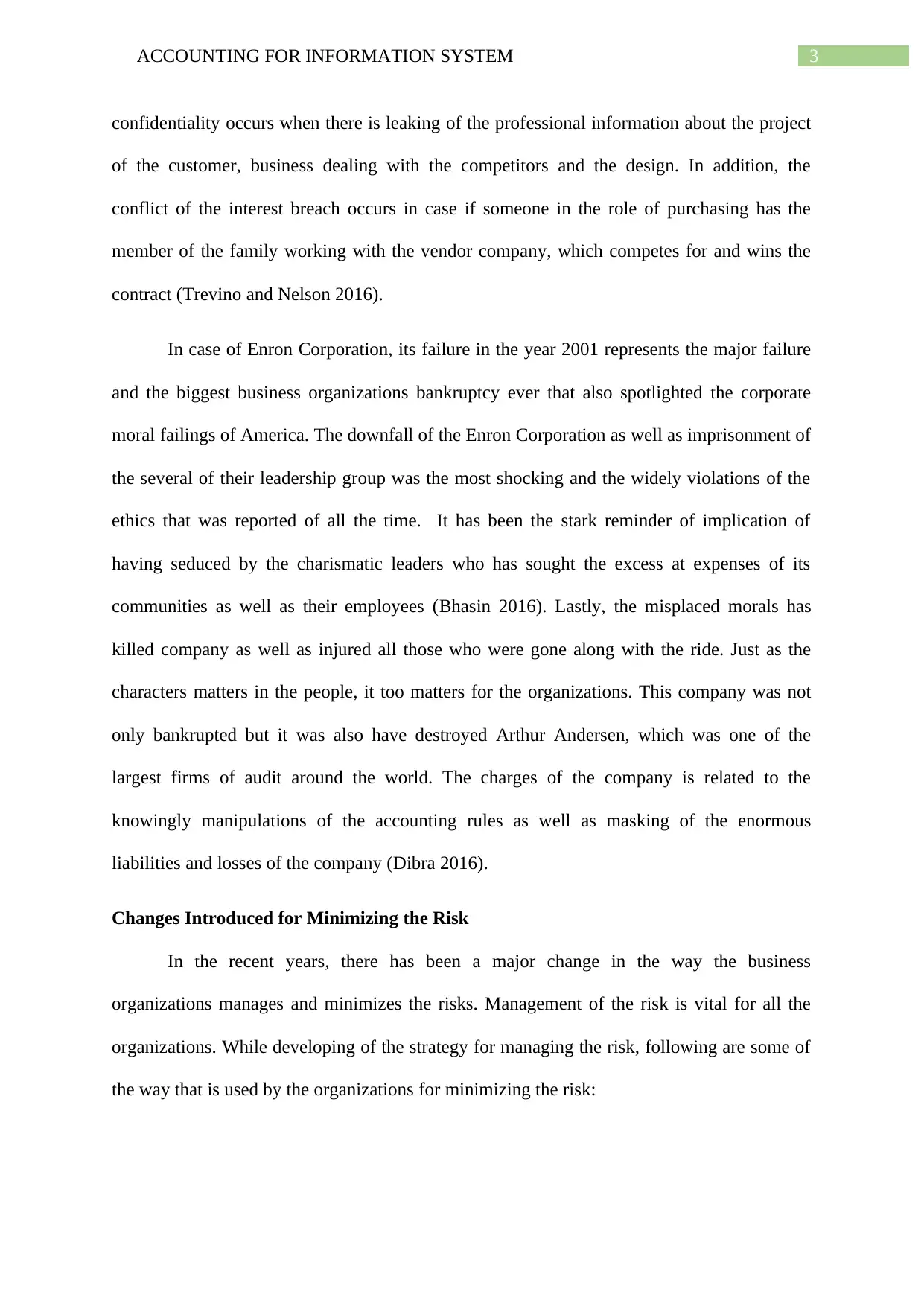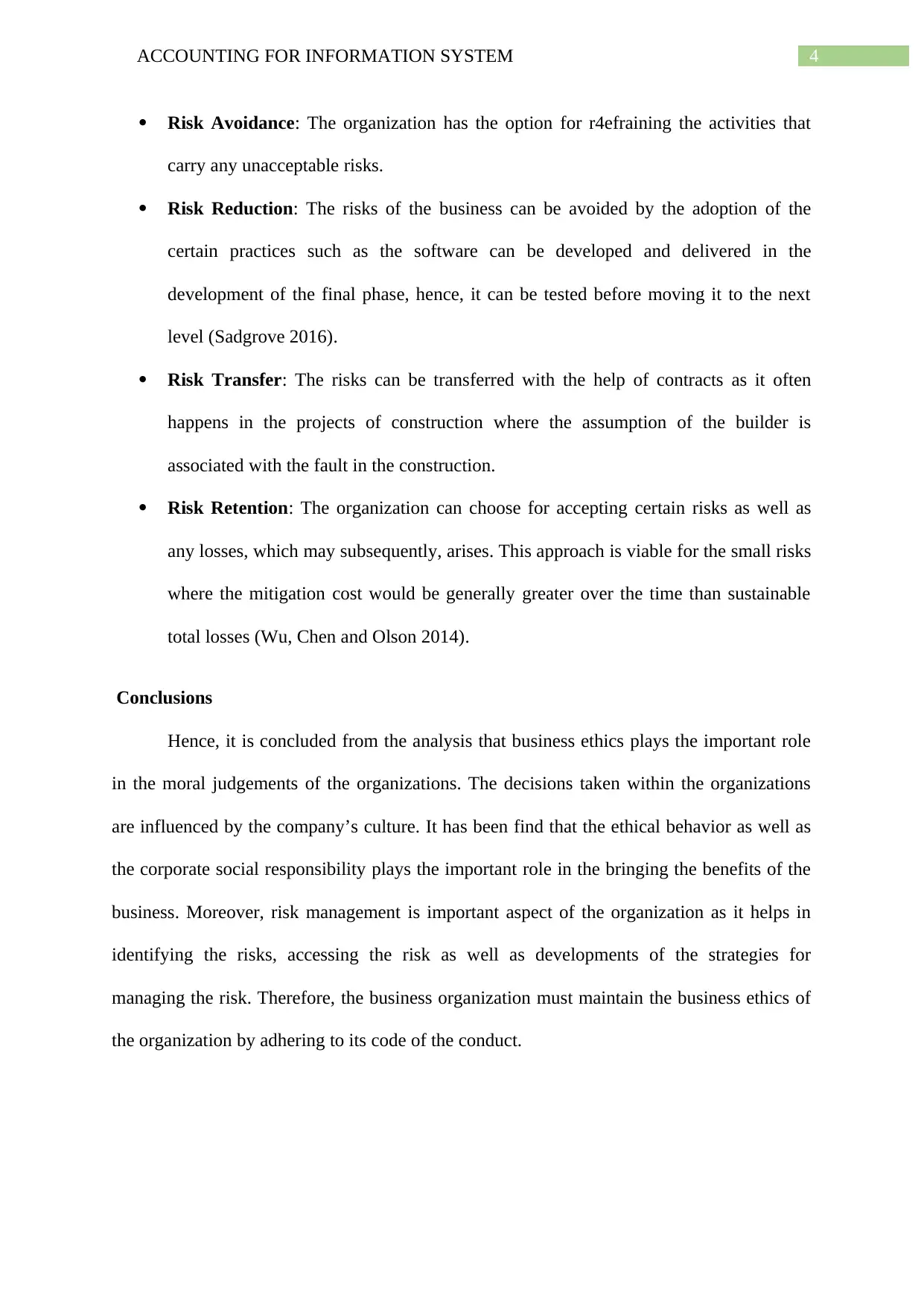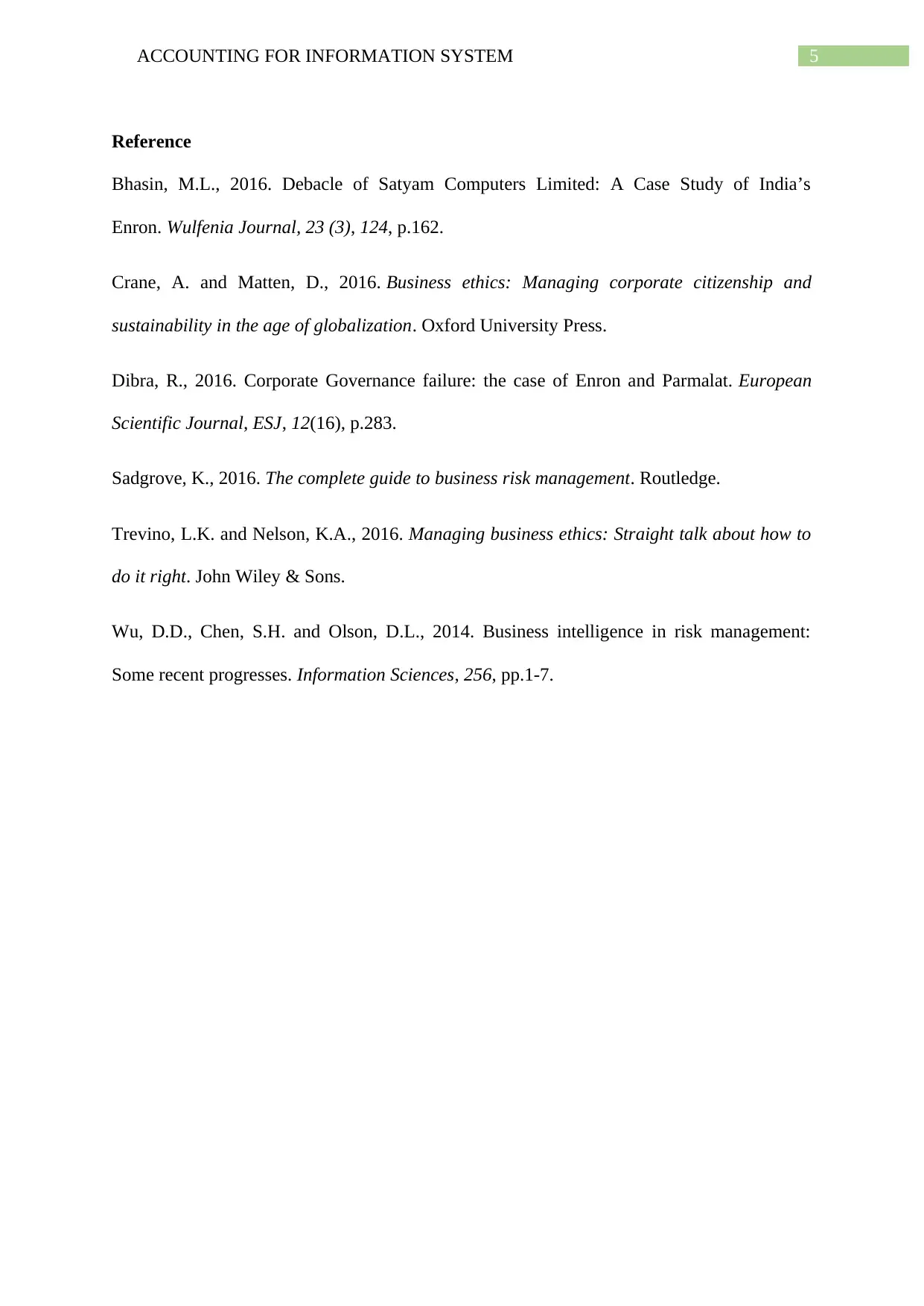Accounting Information Systems: Enron Code of Conduct Breach Analysis
VerifiedAdded on 2023/01/20
|6
|1176
|99
Report
AI Summary
This report provides an in-depth analysis of the ethical failures of Enron Corporation, focusing on breaches of its code of conduct. It examines the nature of these violations, including conflicts of interest and confidentiality breaches, and their impact on the company's downfall. The report also discusses changes introduced to minimize risks in business organizations, such as risk avoidance, reduction, transfer, and retention. By analyzing the Enron case, the report highlights the importance of business ethics, corporate social responsibility, and effective risk management in maintaining organizational integrity and financial stability. The conclusion emphasizes the role of ethical behavior and the development of strategies for managing risks within the organization.

Running Head: ACCOUNTING FOR INFORMATION SYSTEM
ACCOUNTING FOR INFORMATION SYSTEM
Name of the Student
Name of the University
Author Note
ACCOUNTING FOR INFORMATION SYSTEM
Name of the Student
Name of the University
Author Note
Paraphrase This Document
Need a fresh take? Get an instant paraphrase of this document with our AI Paraphraser

1ACCOUNTING FOR INFORMATION SYSTEM
Table of Contents
Introduction................................................................................................................................2
Discussion..................................................................................................................................2
Nature of the Breach of Code of Conduct..............................................................................2
Changes Introduced for Minimizing the Risk........................................................................3
Conclusions................................................................................................................................4
Reference....................................................................................................................................5
Table of Contents
Introduction................................................................................................................................2
Discussion..................................................................................................................................2
Nature of the Breach of Code of Conduct..............................................................................2
Changes Introduced for Minimizing the Risk........................................................................3
Conclusions................................................................................................................................4
Reference....................................................................................................................................5

2ACCOUNTING FOR INFORMATION SYSTEM
Introduction
The aim of this assignment is to do the analysis on the business ethics. Business ethics
is referred as the study and practices of the appropriate business practices and policies in
relation to the potentially subjects are controversial that includes corporate social
responsibility, corporate governance, bribery discrimination, bribery discrimination, insider
trading and fiduciary responsibilities. Under this assignment, the company that will be
considered for the reporting and recording of the breach of the code of the conduct will be of
Enron Corporation. This was Houston based company that was providing services in the
American energy, commodities and services. They have charged for breaching of the code of
the conduct of the company. Hence, the nature of the breach of Code of Conduct or the
business ethics and the issues involved will be discussed. In addition, the discussion will be
done on the changes that are introduced in the organization for minimizing the risk (Dibra
2016).
Discussion
Nature of the Breach of Code of Conduct
The code of conduct is defined as the operating principles, which each of the
members are expected for upholding. In case of the code is associated with the granting of the
license for working in the specific field, the breach will result in the suspending or revoking
of the license, the other consequences and the legal fines may also be applicable in this case.
The code of the conduct is the forma document that the companies prepare for outlining the
standards of the acceptance of the workplace behavior and the ethical decisions for the
employees. Under this, generally the penalty procedures and the discipline are include (Crane
and Matten 2016). There are two examples in the breaches of the code of the conduct that
includes conflict of the breaches of interest and confidentiality. The breach of the
Introduction
The aim of this assignment is to do the analysis on the business ethics. Business ethics
is referred as the study and practices of the appropriate business practices and policies in
relation to the potentially subjects are controversial that includes corporate social
responsibility, corporate governance, bribery discrimination, bribery discrimination, insider
trading and fiduciary responsibilities. Under this assignment, the company that will be
considered for the reporting and recording of the breach of the code of the conduct will be of
Enron Corporation. This was Houston based company that was providing services in the
American energy, commodities and services. They have charged for breaching of the code of
the conduct of the company. Hence, the nature of the breach of Code of Conduct or the
business ethics and the issues involved will be discussed. In addition, the discussion will be
done on the changes that are introduced in the organization for minimizing the risk (Dibra
2016).
Discussion
Nature of the Breach of Code of Conduct
The code of conduct is defined as the operating principles, which each of the
members are expected for upholding. In case of the code is associated with the granting of the
license for working in the specific field, the breach will result in the suspending or revoking
of the license, the other consequences and the legal fines may also be applicable in this case.
The code of the conduct is the forma document that the companies prepare for outlining the
standards of the acceptance of the workplace behavior and the ethical decisions for the
employees. Under this, generally the penalty procedures and the discipline are include (Crane
and Matten 2016). There are two examples in the breaches of the code of the conduct that
includes conflict of the breaches of interest and confidentiality. The breach of the
⊘ This is a preview!⊘
Do you want full access?
Subscribe today to unlock all pages.

Trusted by 1+ million students worldwide

3ACCOUNTING FOR INFORMATION SYSTEM
confidentiality occurs when there is leaking of the professional information about the project
of the customer, business dealing with the competitors and the design. In addition, the
conflict of the interest breach occurs in case if someone in the role of purchasing has the
member of the family working with the vendor company, which competes for and wins the
contract (Trevino and Nelson 2016).
In case of Enron Corporation, its failure in the year 2001 represents the major failure
and the biggest business organizations bankruptcy ever that also spotlighted the corporate
moral failings of America. The downfall of the Enron Corporation as well as imprisonment of
the several of their leadership group was the most shocking and the widely violations of the
ethics that was reported of all the time. It has been the stark reminder of implication of
having seduced by the charismatic leaders who has sought the excess at expenses of its
communities as well as their employees (Bhasin 2016). Lastly, the misplaced morals has
killed company as well as injured all those who were gone along with the ride. Just as the
characters matters in the people, it too matters for the organizations. This company was not
only bankrupted but it was also have destroyed Arthur Andersen, which was one of the
largest firms of audit around the world. The charges of the company is related to the
knowingly manipulations of the accounting rules as well as masking of the enormous
liabilities and losses of the company (Dibra 2016).
Changes Introduced for Minimizing the Risk
In the recent years, there has been a major change in the way the business
organizations manages and minimizes the risks. Management of the risk is vital for all the
organizations. While developing of the strategy for managing the risk, following are some of
the way that is used by the organizations for minimizing the risk:
confidentiality occurs when there is leaking of the professional information about the project
of the customer, business dealing with the competitors and the design. In addition, the
conflict of the interest breach occurs in case if someone in the role of purchasing has the
member of the family working with the vendor company, which competes for and wins the
contract (Trevino and Nelson 2016).
In case of Enron Corporation, its failure in the year 2001 represents the major failure
and the biggest business organizations bankruptcy ever that also spotlighted the corporate
moral failings of America. The downfall of the Enron Corporation as well as imprisonment of
the several of their leadership group was the most shocking and the widely violations of the
ethics that was reported of all the time. It has been the stark reminder of implication of
having seduced by the charismatic leaders who has sought the excess at expenses of its
communities as well as their employees (Bhasin 2016). Lastly, the misplaced morals has
killed company as well as injured all those who were gone along with the ride. Just as the
characters matters in the people, it too matters for the organizations. This company was not
only bankrupted but it was also have destroyed Arthur Andersen, which was one of the
largest firms of audit around the world. The charges of the company is related to the
knowingly manipulations of the accounting rules as well as masking of the enormous
liabilities and losses of the company (Dibra 2016).
Changes Introduced for Minimizing the Risk
In the recent years, there has been a major change in the way the business
organizations manages and minimizes the risks. Management of the risk is vital for all the
organizations. While developing of the strategy for managing the risk, following are some of
the way that is used by the organizations for minimizing the risk:
Paraphrase This Document
Need a fresh take? Get an instant paraphrase of this document with our AI Paraphraser

4ACCOUNTING FOR INFORMATION SYSTEM
Risk Avoidance: The organization has the option for r4efraining the activities that
carry any unacceptable risks.
Risk Reduction: The risks of the business can be avoided by the adoption of the
certain practices such as the software can be developed and delivered in the
development of the final phase, hence, it can be tested before moving it to the next
level (Sadgrove 2016).
Risk Transfer: The risks can be transferred with the help of contracts as it often
happens in the projects of construction where the assumption of the builder is
associated with the fault in the construction.
Risk Retention: The organization can choose for accepting certain risks as well as
any losses, which may subsequently, arises. This approach is viable for the small risks
where the mitigation cost would be generally greater over the time than sustainable
total losses (Wu, Chen and Olson 2014).
Conclusions
Hence, it is concluded from the analysis that business ethics plays the important role
in the moral judgements of the organizations. The decisions taken within the organizations
are influenced by the company’s culture. It has been find that the ethical behavior as well as
the corporate social responsibility plays the important role in the bringing the benefits of the
business. Moreover, risk management is important aspect of the organization as it helps in
identifying the risks, accessing the risk as well as developments of the strategies for
managing the risk. Therefore, the business organization must maintain the business ethics of
the organization by adhering to its code of the conduct.
Risk Avoidance: The organization has the option for r4efraining the activities that
carry any unacceptable risks.
Risk Reduction: The risks of the business can be avoided by the adoption of the
certain practices such as the software can be developed and delivered in the
development of the final phase, hence, it can be tested before moving it to the next
level (Sadgrove 2016).
Risk Transfer: The risks can be transferred with the help of contracts as it often
happens in the projects of construction where the assumption of the builder is
associated with the fault in the construction.
Risk Retention: The organization can choose for accepting certain risks as well as
any losses, which may subsequently, arises. This approach is viable for the small risks
where the mitigation cost would be generally greater over the time than sustainable
total losses (Wu, Chen and Olson 2014).
Conclusions
Hence, it is concluded from the analysis that business ethics plays the important role
in the moral judgements of the organizations. The decisions taken within the organizations
are influenced by the company’s culture. It has been find that the ethical behavior as well as
the corporate social responsibility plays the important role in the bringing the benefits of the
business. Moreover, risk management is important aspect of the organization as it helps in
identifying the risks, accessing the risk as well as developments of the strategies for
managing the risk. Therefore, the business organization must maintain the business ethics of
the organization by adhering to its code of the conduct.

5ACCOUNTING FOR INFORMATION SYSTEM
Reference
Bhasin, M.L., 2016. Debacle of Satyam Computers Limited: A Case Study of India’s
Enron. Wulfenia Journal, 23 (3), 124, p.162.
Crane, A. and Matten, D., 2016. Business ethics: Managing corporate citizenship and
sustainability in the age of globalization. Oxford University Press.
Dibra, R., 2016. Corporate Governance failure: the case of Enron and Parmalat. European
Scientific Journal, ESJ, 12(16), p.283.
Sadgrove, K., 2016. The complete guide to business risk management. Routledge.
Trevino, L.K. and Nelson, K.A., 2016. Managing business ethics: Straight talk about how to
do it right. John Wiley & Sons.
Wu, D.D., Chen, S.H. and Olson, D.L., 2014. Business intelligence in risk management:
Some recent progresses. Information Sciences, 256, pp.1-7.
Reference
Bhasin, M.L., 2016. Debacle of Satyam Computers Limited: A Case Study of India’s
Enron. Wulfenia Journal, 23 (3), 124, p.162.
Crane, A. and Matten, D., 2016. Business ethics: Managing corporate citizenship and
sustainability in the age of globalization. Oxford University Press.
Dibra, R., 2016. Corporate Governance failure: the case of Enron and Parmalat. European
Scientific Journal, ESJ, 12(16), p.283.
Sadgrove, K., 2016. The complete guide to business risk management. Routledge.
Trevino, L.K. and Nelson, K.A., 2016. Managing business ethics: Straight talk about how to
do it right. John Wiley & Sons.
Wu, D.D., Chen, S.H. and Olson, D.L., 2014. Business intelligence in risk management:
Some recent progresses. Information Sciences, 256, pp.1-7.
⊘ This is a preview!⊘
Do you want full access?
Subscribe today to unlock all pages.

Trusted by 1+ million students worldwide
1 out of 6
Related Documents
Your All-in-One AI-Powered Toolkit for Academic Success.
+13062052269
info@desklib.com
Available 24*7 on WhatsApp / Email
![[object Object]](/_next/static/media/star-bottom.7253800d.svg)
Unlock your academic potential
Copyright © 2020–2025 A2Z Services. All Rights Reserved. Developed and managed by ZUCOL.





